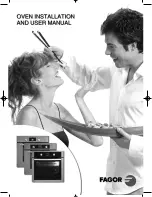
26
Tested for you in our cooking studio
Here you will find a selection of recipes and the ideal settings
for them. We will show you which type of heating and which
temperature or microwave power setting is best for your meal.
You can find information about suitable accessories and the
height at which they should be inserted. There are also tips
about ovenware and preparation methods.
Notes
■
The values in the table always apply to food placed into the
cooking compartment when it is cold and empty. Only
preheat the appliance if the table specifies that you should do
so. Before using the appliance, remove all accessories from
the cooking compartment that you will not be using.
■
Do not line the accessories with greaseproof paper until after
they have been preheated.
■
The times specified in the tables are only guidelines. They will
depend on the quality and composition of the food.
■
Use the accessories supplied. Additional accessories may be
obtained from specialist retailers or from the after-sales
service.
■
Always use an oven cloth or oven gloves when taking
accessories or ovenware out of the cooking compartment.
Defrosting, heating up and cooking with the
microwave
The following tables provide you with numerous options and
settings for the microwave.
The times specified in the tables are only guidelines. They may
vary according to the ovenware used, the quality, temperature
and consistency of the food.
Time ranges are often specified in the tables. Set the shortest
time first and then extend the time if necessary.
It may be that you have different quantities from those specified
in the tables. A rule of thumb can be applied:
Double the amount - almost twice the cooking time,
Half the amount - half the cooking time.
Insert the wire rack at level 1. Place the ovenware in the centre.
The food will then absorb the microwaves from all sides.
Defrosting
Notes
■
Place the frozen food in an open container on the wire rack.
■
Delicate parts such as the legs and wings of chicken or fatty
outer layers of roasts can be covered with small pieces of
aluminium foil. The foil must not touch the cooking
compartment walls. You can remove the foil half way through
the defrosting time.
■
Turn or stir the food once or twice during the defrosting time.
Large pieces of food should be turned several times. When
turning, remove any liquid that has resulted from defrosting.
■
Leave defrosted items to stand at room temperature for a
further 10 to 60 minutes so that the temperature can
stabilise. The giblets can be removed from poultry at this
point.
Defrost
Weight
Microwave power setting in watts,
cooking time in minutes
Notes
Whole pieces of beef, veal or
pork (on the bone or boned)
800 g
180 W, 15 mins + 90 W, 10-15 mins
Turn several times
1 kg
180 W, 15 mins + 90 W, 20
30 mins
1.5 kg
180 W, 25 mins + 90 W, 25-35 mins
Meat in pieces or slices of beef,
veal or pork
200 g
180 W, 5 mins + 90 W, 4-6 mins
Separate any defrosted parts when
turning
500 g
180 W, 8 mins + 90 W, 5-10 mins
800 g
180 W, 10 mins + 90 W, 10-15 mins
Minced meat, mixed
200 g
90 W, 8-15 mins
Turn several times, remove any
defrosted meat
500 g
180 W, 5 mins + 90 W, 10-15 mins
800 g
180 W, 10 mins + 90 W, 15-20 mins
1 kg
180 W, 10 mins + 90 W, 20-25 mins
Poultry or poultry portions
600 g
180 W, 5 mins + 90 W, 13-18 mins
Turn during cooking.
1.2 kg
180 W, 10 mins + 90 W, 10-15 mins
Duck
2 kg
180 W, 10 mins + 90 W, 30-40 mins
Turn several times
Goose
4.5 kg
180 W, 20 mins + 90 W, 60-80 mins
Turn every 20 minutes, remove liquid
that escapes during defrosting
Fish fillet, fish steak or slices
400 g
180 W, 5 mins + 90 W, 10-15 mins
Separate any defrosted parts.
Whole fish
300 g
180 W, 3 mins + 90 W, 10-15 mins
Turn during cooking.
600 g
180 W, 8 mins + 90 W, 10-15 mins
Vegetables, e.g. peas
300 g
180 W, 5-15 mins
Stir carefully during defrosting.
600 g
180 W, 10 mins + 90 W, 8-13 mins
Fruit, e.g. raspberries
300 g
180 W, 5-10 mins
Stir carefully during defrosting and sep-
arate any defrosted parts.
500 g
180 W, 8 mins + 90 W, 5-10 mins
Butter, defrosting
125 g
90 W, 7-9 mins
Remove all packaging.
250 g
180 W, 2 mins + 90 W, 3-5 mins
Loaf of bread
500 g
180 W, 3 mins + 90 W, 10-15 mins
Turn during cooking.
1 kg
180 W, 3 mins + 90 W, 15-25 mins















































